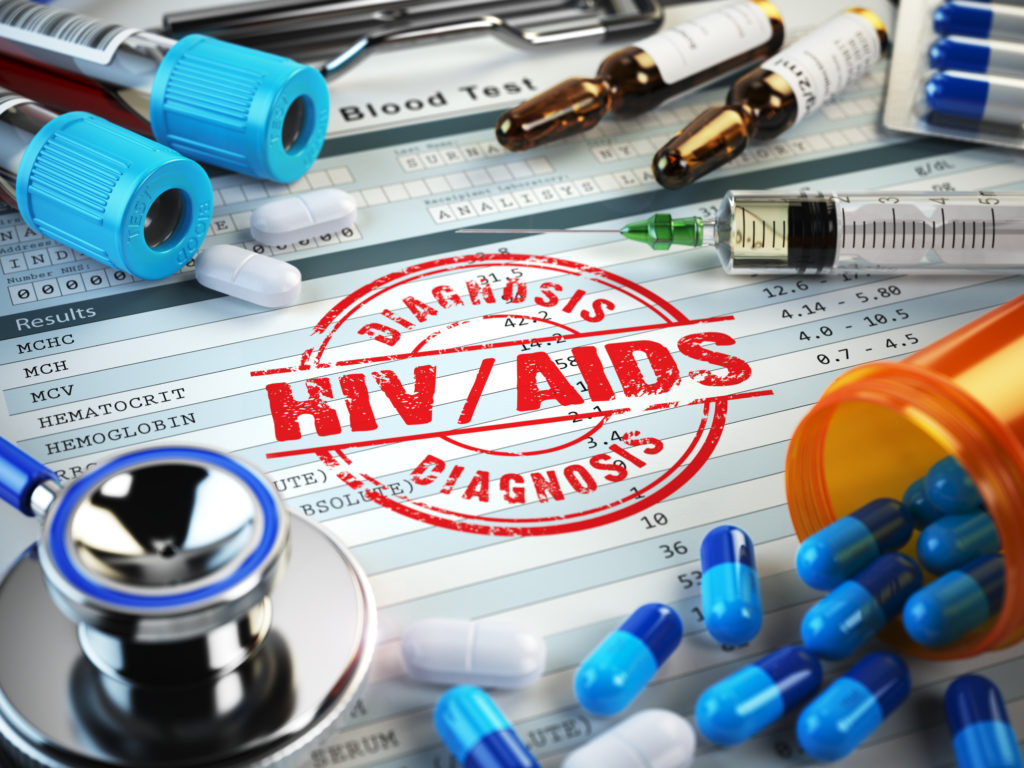
HIV AIDS diagnosis. Stamp, stethoscope, syringe, blood test and pills on the clipboard with medical report. 3d illustration
People who are living with HIV in Ontario have access to good health care and medications, yet they are still dying younger and at substantially higher rates than the rest of the population, according to a new study published today.
The findings suggest that the overall well-being of these people is being negatively impacted by the social determinants of health–non-medical or non-genetic factors such as income, job status, education, housing and incarceration, according to the study in the journal AIDS and Behaviour.
Led by Dr. Sean Rourke, a neuropsychologist at St. Michael’s Hospital and scientist at its Centre for Urban Health Solutions, researchers followed 602 people with HIV recruited from community-based agencies for five years. People with HIV conducted peer-to-peer interviews with other HIV-positive people and then verified who was still alive at one, three and five years, using information, if necessary, obtained from relatives, partners, friends, obituaries and local AIDS memorial lists.
Of the 454 people whose mortality the researchers were able to confirm at the end of the study, 53 had died, which is the equivalent of 22.3 deaths per 100,000 people, substantially higher than the rate in the general population of 6.7 per 100,000 people. Seventy-three per cent of those who died were under 50.
People outside of Toronto died at even higher rates, especially in northern Ontario. (59 per cent outside the Greater Toronto area vs. 42 per cent inside the GTA.)
The study was dedicated to six peer-to-peer researchers, of whom four were among the 53 people who died.
The researchers found that 78 per cent of the study participants were unemployed, 68 per cent had an income under $12,000 a year, 42 per cent had a history of homelessness, and 31 per cent had a history of incarceration.
Individuals who died during the followup period were more likely to have less than high school education (36 per cent versus 20 per cent), be unemployed (89 per cent vs. 77 per cent), have a history of homelessness (57 per cent vs. 39 per cent,) or have a history of incarceration (58 per cent vs. 28 per cent.).
When the researchers divided the study participants by gay men, women and heterosexual men, they found that past incarcerations and homelessness were significant factors among gay men who died, along with poor self-rated health. Dr. Rourke noted that both homelessness and being incarcerated can have significant effects on a person’s health and may even contribute to the progression of HIV, especially right after being incarcerated.
For women and heterosexual men, Caucasian ethnicity, history of incarceration and describing themselves as being in poor or fair health predicted an increased risk of mortality.
Across Canada, an estimated 75,500 people in Canada were living with HIV in 2014, the most recent year for which statistic are available. Due to advances in antiretroviral therapy, the number of deaths due to HIV infection declined by half between 1997 and 2011 and five-year survival rates among those diagnosed with AIDS increased from 7 per cent in 1981-1986 to 65 per cent in 1997-2012.
“Despite these incredible advances in science, we now need to pay much more attention to address the social and structural drivers affecting those living with HIV,” said Dr. Rourke. “This means we need to address mental health and addiction issues, housing, social isolation and income supports, for example. We also need to make sure the health system is redesigned in ways to support access to co-ordinated patient-centred care and services for people living with a chronic disease so that they are not only living healthier, but conditions are in place so that they can thrive into older age. We also need to ensure that people who are released from prison or jail are linked to HIV care and access available social services that help them stay in care.”
This study received funding from the Canadian Institutes of Health Research, the Ontario Ministry of Health and Long-Term Care, the Ontario AIDS Network, the Wellesley Institute and the Ontario HIV Treatment Network.
This paper is an example of how St. Michael’s Hospital is making Ontario Healthier, Wealthier, Smarter.
About St. Michael’s Hospital
St. Michael’s Hospital provides compassionate care to all who enter its doors. The hospital also provides outstanding medical education to future health care professionals in more than 29 academic disciplines. Critical care and trauma, heart disease, neurosurgery, diabetes, cancer care, care of the homeless and global health are among the Hospital’s recognized areas of expertise. Through the Keenan Research Centre and the Li Ka Shing International Healthcare Education Centre, which make up the Li Ka Shing Knowledge Institute, research and education at St. Michael’s Hospital are recognized and make an impact around the world. Founded in 1892, the hospital is fully affiliated with the University of Toronto.
